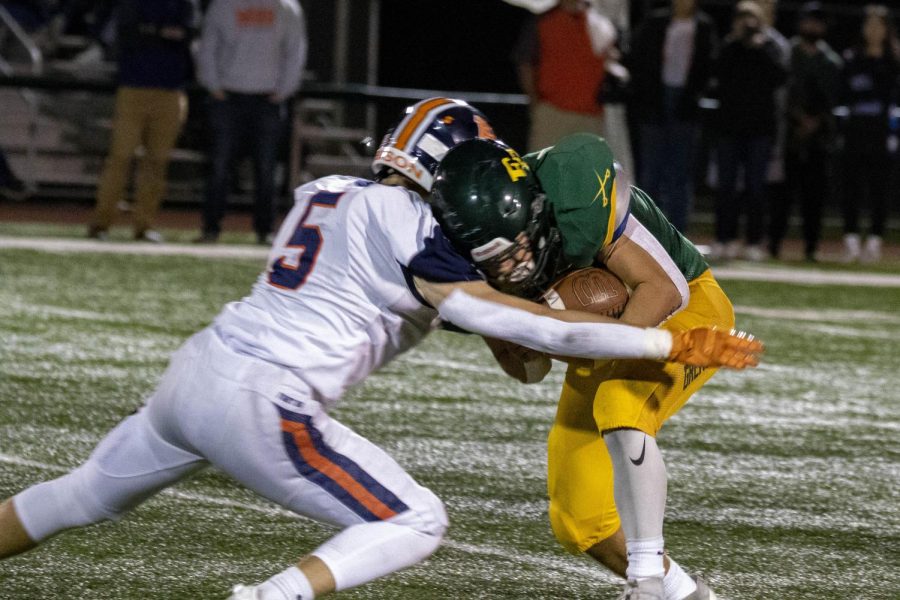Expanding concussion protocol treats injuries seriously
November 15, 2022
The door opens. Michael Milovich steps out, wearing viper sunglasses and a hoodie. He walks to a dark dining room, lit only by the dim oven light. He grabs a plate of food and walks back to his room.
For the sophomore Milovich, this wasn’t his choice. It was a necessity, a way to adapt to his circumstances. He was forced to live in the dark for almost two months as a result of a concussion.
High school is one of the most important times for a person’s brain to develop, so a big hit to the head can potentially cause a lot of problems. Concussion symptoms, per the Centers for Disease Control and Prevention, include headaches, nausea, balance problems, sensitivity to the senses, feeling sluggish, confusion and memory problems. Athletes who experience a concussion have to undergo an intense protocol, which has helped athletes like Milovich.
Although Milovich doesn’t remember what actually happened during that frosh-soph football game against Prospect in 2021, he has a series of what was told to him, and he can piece it all together after the fact.
“From what I was told, we were going and I made a tackle like this,” Milovich said, showing a hugging arms that is typical of most tacklers. “And my helmet was a little bit too loose. I made the tackle, my head bounced and my head rattled inside.”
Milovich chose to stay playing for two more drives, which he later regretted.
“Instead of being responsible and pulling myself out, I kept playing,” he said.
His family would later tell him that he was speaking straight, but he kept trying to reach for his helmet and had a fuzzy memory. Afterwards, the athletic trainer kept him out of school — and effectively, the world — for two months as a result of his concussion diagnosis.
“The first few weeks were the hardest because I had no phone, no TV, no nothing,” Milovich said. “Just kind of laying there, and just relaxing. They gave me black out shades so no light could get in.”
The protocols and recovery time in place have changed over time, especially in recent years. Milovich’s head coach Miles Osei played both high school and college football, and he started coaching right after his playing career.
“Overall, the awareness for head injuries in all sports has increased, which is good,” Osei said. “I think people take those seriously, those protocols are serious, especially at the high school level.”
Osei knows this first hand, as he suffered a head injury while playing for Illinois. It happened in a game against Wisconsin.
“It’s an intense protocol,” Osei said. “They make sure that you take care of yourself and you’re able to do the things the training staff are asking you to do.”
He added that the training staff at the University of Illinois Urbana-Champaign did an excellent job.
“The first thing they did was take my helmet away, and I couldn’t play the rest of the game,” he said. “They monitor you and they’d ask several series of questions and mental tests just to make sure.”
Once they were symptom-free, the training staff goes through a long checklist.
He also said that the team contacted Osei’s professors so that they were aware and were accommodating and supportive. This is also the case at Elk Grove for athletes like Milovich.
“We don’t mess around with players with head injuries,” Osei said. “I don’t know a coach that doesn’t take it seriously, especially at the high school level.”
Over the course of this year’s football season, there was only one head injury. Osei said he agrees that a lower rate of head injuries stems from teaching kids how to properly tackle and better equipment.
“I think our staff does a good job teaching the kids how to tackle from Day One, and the equipment is so much better,” Osei said. “A lot of things you heard in many years of build up is from equipment that’s not up to standard. Our modern football tech is some of the best. Our kids are in SpeedFlexes, which is one of the top helmets.”
A lot has changed in the last 10 years. Head injuries don’t always stem from one big hit, but rather a bunch of little blows that add up over time. Research from Bennet Omalu, who was the subject of the movie “Concussion,” backs that up.
Irving Gonzalez has been in the athletic training field for more than a decade and has been at Elk Grove since 2020. He doesn’t see concussions all that much on a daily basis, but he did say that he sees a head injury in the office once a week typically. It isn’t just football players like Milovich who have head injuries or concussions.
“I’ve seen it all here,” Gonzalez said. “I had concussions or concussion-like symptoms with gymnastics, basketball, and wrestlers. I’ve even seen a swimmer get concussion-like symptoms.”
The protocol, as Gonzalez puts it, is a culmination of what physicians and experience says. It contains both reflexive and physical activities.
“The first was one-foot jumping, dropping a ball, tossing a ball and catching,” Milovich said. “The next few days was endurance, like running in the weight room and 10 burpees or 10 pushups.”
Gonzalez said that one of the protocols that has to be followed to a tee is a head injury. It’s a five-day protocol, with symptom checks on Day No. 1. On the second day, if a student doesn’t have symptoms, they try some sort of physical activity. They are constantly testing before and after for their symptoms. They progress through this five-day protocol and return to practice when they can prove they’re back to normal.
“We want to return them to play as soon and as safe as possible,” Gonzalez said.
The longest someone’s been in the protocol was a soccer player.
“Two months,” Gonzalez recalled.
Even though the process can be long and strenuous, athletes understand how important it is to take it seriously.
“It’s super important to take care of yourself,” Milovich said.






